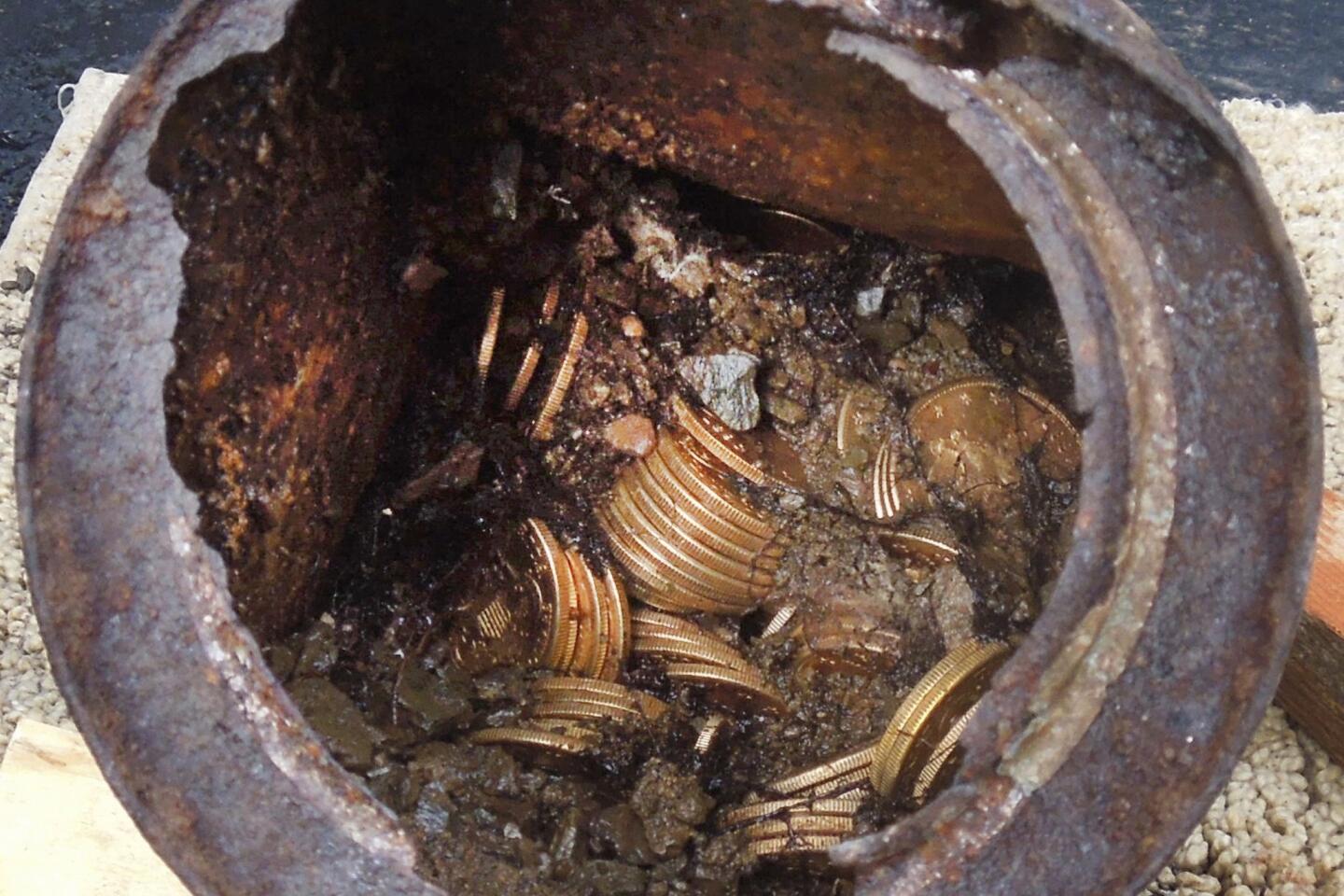‘Gold fever’ still alive after coin discovery, historian says
- Share via
“Gold fever” is still alive, a California historian said after last week’s discovery of more than 1,400 coins buried on a Northern California couple’s gold country property.
The historic find, believed to be the most valuable in North America, has had people around the world buzzing since the announcement by numismatic firm Kagin’s Inc., which evaluated the hoard and is representing the couple.
“There’s something about gold, ever since the days of legendary King Midas, it’s just incredible people’s response to this,” said Gary Kurutz, director of special collections at the California State Library.
PHOTOS: California couple discovers cache of gold coins
Men have danced, jumped and shouted for joy, described having the metal “badly on the brain,” and James Marshall, who in 1848 saw the glint that set off the California Gold Rush, recalled his heart thumping at the certainty of what he had found, Kurutz said.
For the lucky couple, identified by Kagin’s only as John and Mary, it was “impossible to describe, the strange reality of that moment,” John said in an interview transcript.
“I found a can of gold coins and I thought there was a zero percent chance of Mary believing me! When I told her, the look of bewilderment – her mouth was so wide open flies could have flown in and out several times,” he said.
When they realized what they had, they dug a hole in their wood pile, placed the coins in bags and boxes in an old ice chest and buried them again before deciding what to do next.
“The metal of all metals for which, some people say, the whole world stood and worshiped. The common man, the rich man, they all want to be involved,” Kurutz said.
And that spirit is still alive today – the idea that one could be in the right place at the right time, win the lottery or strike it rich.
“Instant wealth,” Kurutz said.
Speculation has swirled about the origin of the coins since last week’s announcement of the Saddle Ridge Hoard. Some believe they are part of a $30,000 cache that went missing from the San Francisco Mint in a 1901 theft, or perhaps one of many treasure stashes believed buried across a dozen states by the secretive, subversive Confederate group the Knights of the Golden Circle.
The coins were not likely those stolen in the turn-of-the-century defalcation for which Chief Clerk Walter Dimmick served time in San Quentin.
There is no connection between the historic theft and the Saddle Ridge Hoard, said U.S. Mint spokesman Adam Stump. Officials looked into the matter when they heard about it last week, and will not take any action, he said.
The coins could very well be a fortune buried by a wealthy businessman, but the time period, markers near the cache and manner in which the coins were buried fit the mold of the KGC, said Warren Getler, a former Wall Street Journal reporter who coauthored “Rebel Gold,” a book about the group.
Getler and coauthor Bob Brewer argue in the book the KGC existed for many decades after the Civil War and continued to bury and protect underground gold and silver caches.
Still others have suggested the treasure might be that of their relatives, who once owned property in gold country -- but was it near the valuable find?
Kagin’s did extensive research to determine whether the coins were ill-gotten, said David McCarthy, senior numismatist for the firm. Despite hearing from quite a few people, Kagin’s has not received any credible claims to the coins and does not expect to, he said.
The couple had walked the path on their gold country property for years before they spotted the edge of a rusty can peeking out of the moss in February 2013. When the lid cracked off, they found dirt-encrusted coins, some in better condition than those on display in museums.
The Saddle Ridge Hoard, named for the space on their property, has an estimated value of more than $10 million. If you melted the coins, the gold alone would be worth $2 million, said David Hall, co-founder of Professional Coin Grading Services in Newport Beach, who recently authenticated them.
The cache contains a mix of coins with 72 distinct date and mint mark combinations, McCarthy said. The 1,427 coins, most of them $20 pieces, are dated between 1847 and 1894. Thirteen of the coins are the finest of their kind.
One “miraculous coin,” an 1866 $20 piece made in San Francisco and missing “In God We Trust,” could bring $1 million on its own, Hall said. When the motto was added to the coin in 1866, some were still minted without the phrase, he said.
Most of the hoard will be sold on Amazon.com in late May or early June to allow a broader swath of the public to access them, McCarthy said. The couple, who will donate some of the profit to charity, said the find will allow them to keep their property.
Twitter: @Sam_Schaefer
More to Read
Sign up for Essential California
The most important California stories and recommendations in your inbox every morning.
You may occasionally receive promotional content from the Los Angeles Times.















